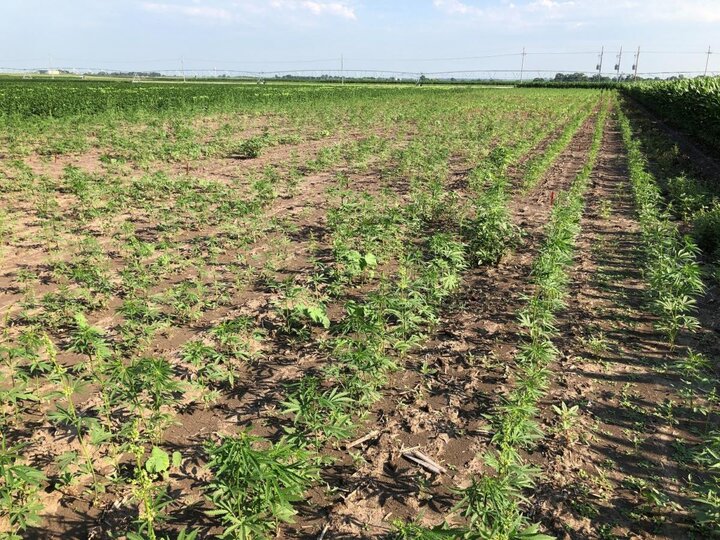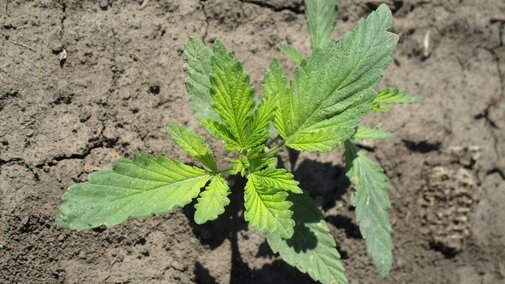Nebraska legalized industrial hemp in 2019, which created much interest in researching various aspects of hemp production, including weed control. Therefore, we initiated study at Agronomy Farm in Mead, with the objective to test hemp tolerance to 18 soil-applied herbicides that are commonly used for preemergence weed control in corn or soybean.
Hemp Herbicide Tolerance Series
- Industrial Hemp Tolerance to Soil-applied Herbicides
- Industrial Hemp Varieties Exhibit the Same Tolerance Level to PRE-Herbicides
- Industrial Hemp Tolerance to Early-POST Herbicides
- Industrial Hemp Tolerance Late-POST Herbicides
- Industrial Hemp Tolerance to Flame Weeding
Industrial hemp (variety X-59 for fiber) was planted on June 8, 2020 in 30” rows, 0.5” deep and at about 20 thousand seeds per acre (10lbs / acre). Herbicides (Table 1) were sprayed on June 9, one day after planting. Hemp emerged on June 15th. Study was arranged in the randomized compete block design with 3 replications with 30 ft plots. Hemp injury ratings were conducted at 15, 21, and 28 days after treatment (DAT) utilizing the scale from 0-100 (0=no injury; 100=dead plant).
There were no weed control ratings collected because late hemp planting, and cultivations prior to planting controlled multiple weed flushes. For individual weed response ratings to tested soil applied herbicides please check the corn and soybean sections of the Guide for Weed, Disease and Insect Management in Nebraska.
Results:
Hemp exhibited variable tolerance levels to tested herbicides. Visual injury levels ranged from no injury (0%) to temporary injury (50%).
No hemp injury was evident in plots with Sharpen, Stinger, Permit, or Prowl H20, which appeared to be the most promising soil-applied herbicides for hemp production, at least from the list we tested (Table 1).
Temporary hemp injury, which lasted first two weeks, was evident in multiple plots, in the form of leaf yellowing. The injury levels at 15 DAT ranged from 5-20% depending on the herbicide. For example, Dual II Magnum caused 10% visual injury compared to 20% with Hornet, Python and Surestart (Table 1, Photo 2). More importantly, by 21 DAT most of those injuries were reduced to about 5%, and by 28 DAT to zero, indicating hemp recovery.
Severe hemp injury (50-80%) was caused by Valor EZ, Balance Flex, and Command (Photo 1) at 21 DAT. By 28 DAT, hemp plants died in plots sprayed with Balance Flex and Command (Table 1).
Table 1. Hemp injury ratings at 15, 21 and 28 day after treatment (DAT) to 18 herbicides.| Herbicide (rate/acre) | 15 DAT | 21 DAT | 28DAT |
|---|---|---|---|
| 1. Sharpen (1oz) | 0 | 0 | 0 |
| 2. Dual II Magnum (1.67pt) | 8 | 0 | 0 |
| 3. Hornet (2oz) | 20 | 5 | 0 |
| 4. Sharpen+ Dual II Magnum | 13 | 5 | 0 |
| 5. Sharpen + Hornet | 8 | 3 | 0 |
| 6. Hornet + Dual II Magnum | 13 | 5 | 0 |
| 7. Sharpen+ Dual II Magnum+ Hornet | 18 | 6 | 0 |
| 8. Python (0.46 oz) | 20 | 5 | 0 |
| 9. Stinger (2.66 oz) | 0 | 0 | 0 |
| 10. Surpass NXT (13.2 oz) | 23 | 3 | 0 |
| 11. SureStart II (1.54 pt) | 25 | 5 | 8 |
| 12. Balance Flexx (6 oz) | 56 | 81 | 100 |
| 13. Permit (0.66 oz) | 0 | 0 | 0 |
| 14. Prowl H2O (3pt) | 0 | 0 | 0 |
| 15. Tricor 4F (8 oz) | 25 | 5 | 0 |
| 16. Command (32oz) | 75 | 85 | 93 |
| 17. Sulfenzatrone 4F (8 oz) | 23 | 5 | 0 |
| 18. Valor EZ (2.04 oz) | 48 | 18 | 5 |



Conclusion:
Hemp exhibited relatively good tolerance to many products tested. Sharpen, Stinger, Permit and Prowl H20 caused no hemp injury, thus they should be safe to use. Hornet, Python, Surpass NXT, Surestart II, Tricor 4F and Sulfentrazone SF have also potential for use. The temporary injury from those products are considered acceptable since they lasted only for a week or two. The hemp grew out of injuries and developed normal plants. Balance Flex and Command caused unacceptable injuries, thus should not be used. It is important to note that the above conclusions are based only on one year of data, this study will be repeated in 2021 season.
Side note: It was interested to note that the young hemp plants (10-15” tall) exhibited fair amount of lodging after the 2” of hard rain and wind (gust up 40MPH) (Photo 4). They recovered a week later.


